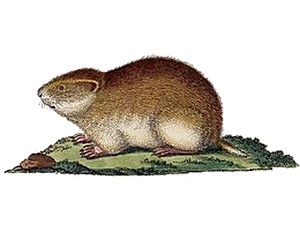
Chipmunks are small, striped rodents of Sciuridae, the squirrel family; specifically, they are ground squirrels (Marmotini). Chipmunks are found in North America, with the exception of the Siberian chipmunk which is found primarily in Asia.

The Haliplidae are a family of water beetles that swim using an alternating motion of the legs. They are therefore clumsy in water, and prefer to get around by crawling. The family consists of about 200 species in 5 genera, distributed wherever there is freshwater habitat; it is the only extant member of superfamily Haliploidea. They are also known as crawling water beetles or haliplids.

The Norway lemming, also known as the Norwegian lemming is a common species of lemming found in northern Fennoscandia, where it is the only vertebrate species endemic to the region. The Norway lemming dwells in tundra and fells, and prefers to live near water. Adults feed primarily on sedges, grasses and moss. They are active at both day and night, alternating naps with periods of activity.

The genus Lemmus contains several species of lemming sometimes referred to as the true lemmings. They are distributed throughout the Holarctic, particularly in the Palearctic.

Chilantaisaurus is a genus of large theropod dinosaur, possibly a neovenatorid or a primitive coelurosaur, from the Late Cretaceous Ulansuhai Formation of China. The type species, C. tashuikouensis, was described by Hu in 1964.

The Siberian chipmunk, also called common chipmunk, is native to northern Asia from central Russia to China, Korea, and Hokkaidō in northern Japan. It was imported from South Korea and introduced in Europe as a pet in the 1960s.

Leonurus sibiricus, commonly called honeyweed or Siberian motherwort, is an herbaceous plant species native to China, Mongolia, and Siberia. It has verticillaster inflorescence. It is naturalized in many other parts of the world, including South, Central and North Americas.

The WestSiberian lemming or Western Siberian brown lemming is a true lemming species found in the Russian Federation. Like other lemmings, it belongs to the Cricetidae family of rodents.

The Siberian long-tailed rosefinch is a species of finch of the family Fringillidae.

Haliplus is a genus of crawling water beetles in the family Haliplidae. There are at least 180 described species in Haliplus. They are found worldwide, except for Antarctica, living among algae and aquatic vegetation at edges of ponds, lakes, and streams. They range in size from 1.75 to 5 mm.

Suillus sibiricus is a mushroom-forming fungus in the family Suillaceae. It is found in mountains of Europe, North America, and Siberia, strictly associated with several species of pine tree. Due to its specific habitat and rarity in Europe, it has been selected for inclusion in several regional Red Lists. Its fruit bodies are characterised by having slimy caps in wet weather, which can reach diameters of up to 10 cm (3.9 in). On the underside of the cap are yellow angular pores that bruise a pinkish to cinnamon colour. The stem is up to 8 cm (3.1 in) tall and 2.5 cm (1.0 in) wide and typically has a ring, a remnant of the partial veil that covers the fruit body in its early development. In North America, it is commonly called the Siberian slippery jack. Phylogenetic analysis has shown that S. sibiricus is closely related to S. umbonatus and S. americanus, and may in fact be conspecific with the latter species.

Spodiopogon sibiricus is a species of perennial grass in the family Poaceae.
Haliplus crassus is a species of beetle in the Haliplidae family that can be found in Brazil, Panama, Paraguay, and Venezuela. It flies from May to October. Adults are as long as 3.7–4.2 millimetres (0.15–0.17 in) while its larvae are 2.1–2.5 millimetres (0.083–0.098 in) long.

Haliplus ruficollis is a species of water beetle from the Haliplidae family that can be found everywhere in Europe, the Near East and the East Palaearctic, but is absent in Albania and all European islands except for Corsica.
Haliplus apicalis is a species of water beetle in the genus Haliplus. It can be found on British Isles and in North-West Europe.
Haliplus furcatus is a species of water beetle from Haliplidae, family that can be found in Central Europe and Northwestern Europe.

Helophorus sibiricus is a species of water scavenger beetle in the family Hydrophilidae. It is found in Northern Europe, Northern Asia, and Alaska. Fossils from Early Miocene sediments of the Irtysh River in western Siberia have been reliably assigned to this species, which means that Helophorus sibiricus existed already 16-23 million years ago.

The Ezo chipmunk is a subspecies or local population of the Siberian chipmunk; it is found in what was once known as Ezo, namely Hokkaidō, Japan, and Sakhalin and the Southern Kuriles, Russia.

The East Siberian lemming, Eastern Siberian brown lemming, or Ognev's lemming is a species of lemming endemic to Russia, where it has a disjunct distribution throughout parts of Siberia east of the Verkhoyansk Range.














